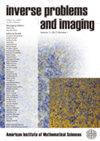基于少量低分辨率切片的超分辨率表面重建
IF 1.5
4区 数学
Q2 MATHEMATICS, APPLIED
引用次数: 0
摘要
在许多成像应用中,将分割的特征(例如血管)进一步用于其他数值模拟(例如有限元分析),所获得的表面不具有适合该任务的精细分辨率。提高这类表面的分辨率变得至关重要。本文提出了一种新的变分模型来解决这一问题,该模型基于欧拉-弹性正则化器。此外,我们提出并实现了两种求解模型的数值算法:投影梯度下降法和乘子交替方向法。使用现实生活中的例子(包括两个来自另一个变分模型的输出)的数值实验已经证明了有效性。从离散几何的角度对高斯曲率和平均曲率的标准差进行了定量比较,说明了新模型的优越性。本文章由计算机程序翻译,如有差异,请以英文原文为准。
Super-resolution surface reconstruction from few low-resolution slices
In many imaging applications where segmented features (e.g. blood vessels) are further used for other numerical simulations (e.g. finite element analysis), the obtained surfaces do not have fine resolutions suitable for the task. Increasing the resolution of such surfaces becomes crucial. This paper proposes a new variational model for solving this problem, based on an Euler-Elastica-based regulariser. Further, we propose and implement two numerical algorithms for solving the model, a projected gradient descent method and the alternating direction method of multipliers. Numerical experiments using real-life examples (including two from outputs of another variational model) have been illustrated for effectiveness. The advantages of the new model are shown through quantitative comparisons by the standard deviation of Gaussian curvatures and mean curvatures from the viewpoint of discrete geometry.
求助全文
通过发布文献求助,成功后即可免费获取论文全文。
去求助
来源期刊

Inverse Problems and Imaging
数学-物理:数学物理
CiteScore
2.50
自引率
0.00%
发文量
55
审稿时长
>12 weeks
期刊介绍:
Inverse Problems and Imaging publishes research articles of the highest quality that employ innovative mathematical and modeling techniques to study inverse and imaging problems arising in engineering and other sciences. Every published paper has a strong mathematical orientation employing methods from such areas as control theory, discrete mathematics, differential geometry, harmonic analysis, functional analysis, integral geometry, mathematical physics, numerical analysis, optimization, partial differential equations, and stochastic and statistical methods. The field of applications includes medical and other imaging, nondestructive testing, geophysical prospection and remote sensing as well as image analysis and image processing.
This journal is committed to recording important new results in its field and will maintain the highest standards of innovation and quality. To be published in this journal, a paper must be correct, novel, nontrivial and of interest to a substantial number of researchers and readers.
 求助内容:
求助内容: 应助结果提醒方式:
应助结果提醒方式:


